MARIANI’S
Virtual
Gourmet
May
8, 2022
NEWSLETTER
ARCHIVE

"August: Osage County" (2013)
HAPPY MOTHER'S DAY!
IN THIS ISSUE
EATING AS THE ROMANS DO
By John Mariani
NEW YORK CORNER
SICILY OSTERIA
By John Mariani
ANOTHER VERMEER
CHAPTER EIGHTEEN
By John Mariani
❖❖❖
 Michael Pitts
about the little known contributions of
Columbia Pictures to the horror-sci-fi
genre. Go to: WVOX.com.
The episode will also be archived at: almostgolden.
Michael Pitts
about the little known contributions of
Columbia Pictures to the horror-sci-fi
genre. Go to: WVOX.com.
The episode will also be archived at: almostgolden.
❖❖❖
EATING AS
THE ROMANS DO
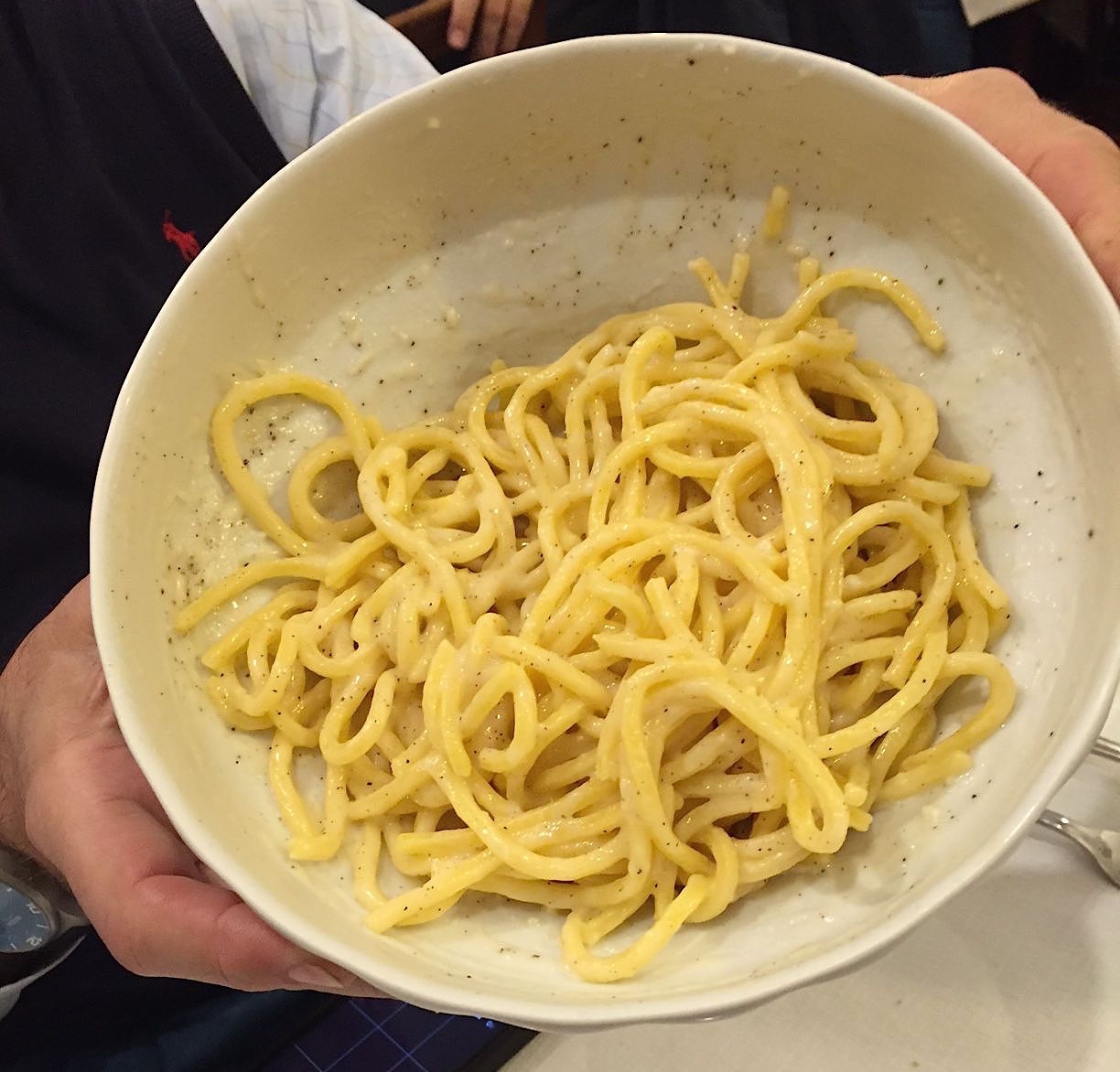
By John Mariani
I
confess that I haven’t been to Rome since
before the pandemic, and it is my intent to now
return as soon as possible, not least to visit
some of my favorite ristoranti
and trattorie
as well as check out new places. But
here’s the thing about Rome’s restaurant scene:
New, especially as novelty, is not particularly
regarded highly, although there are a few young
chefs pushing into modernist corners in search
of Michelin stars (which usually results in
half-full dining rooms). Ask a concierge what’s
“new” in town and he is likely to recommend a
place that opened five years ago.
 Second,
Roman restaurants tend not to change from year
to year, even decade to decade, so that I always
feel safe recommending a place I haven’t been to
in a while with full confidence it will be every
bit as good as I say it will be. Many are family
owned, and even if it’s not the original family,
another one bought it and maintains it.
Second,
Roman restaurants tend not to change from year
to year, even decade to decade, so that I always
feel safe recommending a place I haven’t been to
in a while with full confidence it will be every
bit as good as I say it will be. Many are family
owned, and even if it’s not the original family,
another one bought it and maintains it.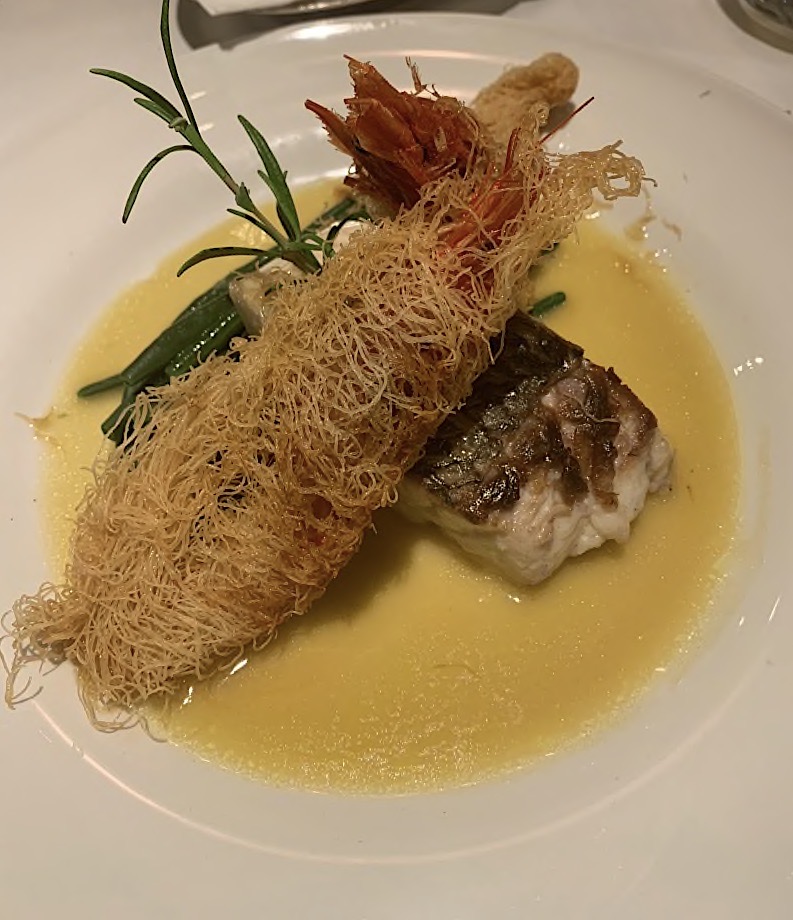
Every long-time visitor to Rome has his
or her favorites, and many restaurant names pop
up again and again in articles. Some of these I
recommend below are very well known, some are in
season frequented by tourists—who, by the way,
keep restaurants worldwide in business.
So, take my advice, and write back to let me
know if some place that’s been serving Roman
food for fifty years has somehow gone sadly into
decline. Somehow I doubt it.
La Rosetta (Via della Rosetta, 8/9),
which claims to be Rome’s first true seafood
restaurant, has never been challenged on that
score since opening in 1966 (before
that it was a rosticceria dating back to 1763). Owners
Carmelo Riccioli and Romana Colella, now with
son Massimo (left) in the kitchen, keep
everyone happy with fritture—crisply
fried
seafood, sprinkled with chopped mint and a
squeeze of lemon (30€). This is one of the few
places where I really love the seafood pastas,
especially linguine
con astice, with sweet Mediterranean
lobster (35€). Wonderful seafood risotto (33€)!
Simple? Impeccably so, but La Rosetta also does
many innovative, more complex dishes, like seared red mullet
fillets with sage with cardoncelli
mushrooms (30€); lobster and scallops au
gratin with Champagne and chicory (45€);
lobster gratin with Champagne sauce and
artichokes (33€); and a “Big Fish and
Shellfish Soup” to share (45€).
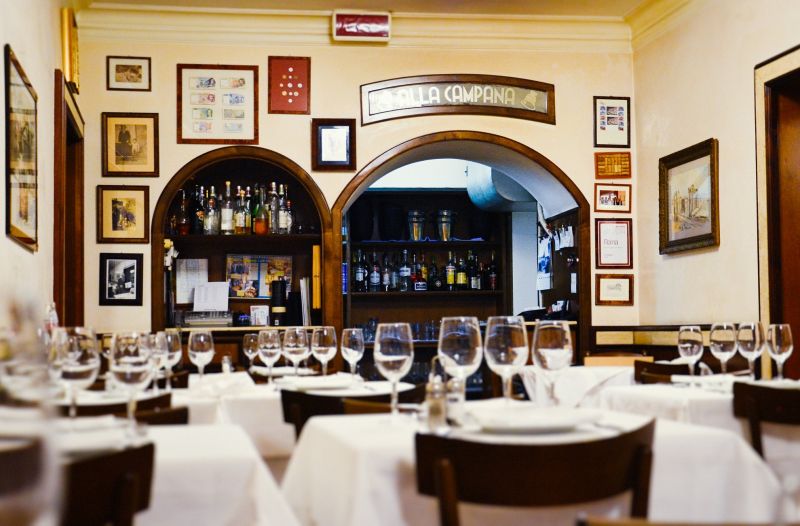 For
something much, much older there is the revered
and beloved La Campana
(Via della
Lungara, 41) near the
Campo di Fiori. It dates back to 1518, and the
room is barebones (left), always packed
with locals. The menu is basic Roman with all
the usual pastas, a very wide selection of
antipasti alla
tavola, and specials throughout the week,
including offal, which is a Roman passion. It’s
not rushed, but it’s not a place to linger, and
you’ll find the veteran staff very eager to
please you with whatever you order. The coda alla
vaccinara (braised oxtail)
For
something much, much older there is the revered
and beloved La Campana
(Via della
Lungara, 41) near the
Campo di Fiori. It dates back to 1518, and the
room is barebones (left), always packed
with locals. The menu is basic Roman with all
the usual pastas, a very wide selection of
antipasti alla
tavola, and specials throughout the week,
including offal, which is a Roman passion. It’s
not rushed, but it’s not a place to linger, and
you’ll find the veteran staff very eager to
please you with whatever you order. The coda alla
vaccinara (braised oxtail)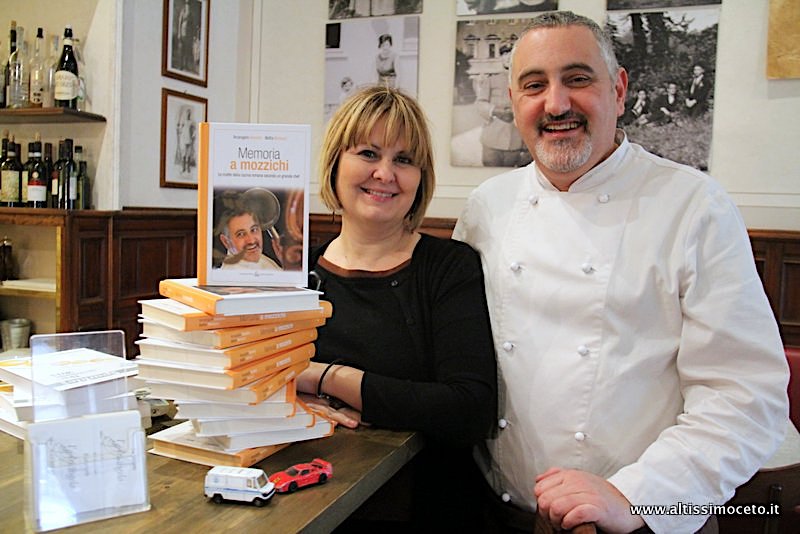 with rigatoni (19€) is delicious, as are the
fried artichokes (6€).
with rigatoni (19€) is delicious, as are the
fried artichokes (6€).
For an impeccable marriage of the
traditional and the new, head for L’Arcangelo
(Via Giuseppe
Giocchino Belli, 59/61 )
in the Prati district, now ten years old, where
Stefania and Arcangelo Dandini (right)
show an ebullience that translates into
sumptuous renderings of Roman classics like
gnocchi potato dumplings with dried tomatoes,
salt cod, and mint (13€) ; tagliatelle
with dried porcini mushrooms
(13€); onion ravioli with herbs and butter and a
sweet-and-sour sauce (13€); cheese-stuffed lamb
with an egg sauce (18€); and cod and tomato
sauce with plums and dried fruit (16€). Don’t
miss the terrific Italian charcuterie from
artisanal master Fulvio Pierangelini.
La
Matricianella (Via del
Leone, 4), snug in an alleyway near
the Piazza Borghese, has been around since 1957,
opened by a family  from
Amatrice (where pasta all’amatriciana
comes from) and owned since 1995 by brother and-
ister Giacomo and Grazia Le Bianco, who welcome
everyone like family. Chefs Giovanni Fabbrotti,
Lorenzo Vannucchi and Stefano Timi specialize in
delicately fried foods, twelve of them, like
artichokes alla giudia
(7€); baccalà (8€),
stewed tripe (right) and much
else. The tagliolini with
truffles
(18€) and tonnarelli with
a
spicy arrabiata
sauce (11€) are terrific. For a main course
go with the sage-scented saltimbocca
(18€) or the grilled lamb
sweetbread (18€).
from
Amatrice (where pasta all’amatriciana
comes from) and owned since 1995 by brother and-
ister Giacomo and Grazia Le Bianco, who welcome
everyone like family. Chefs Giovanni Fabbrotti,
Lorenzo Vannucchi and Stefano Timi specialize in
delicately fried foods, twelve of them, like
artichokes alla giudia
(7€); baccalà (8€),
stewed tripe (right) and much
else. The tagliolini with
truffles
(18€) and tonnarelli with
a
spicy arrabiata
sauce (11€) are terrific. For a main course
go with the sage-scented saltimbocca
(18€) or the grilled lamb
sweetbread (18€).
The wine
list is one of the most comprehensive in the
city, especially for a trattoria, and you should
visit the wine cellar downstairs.
La Carbonara, set on
the gorgeous Campo dei Fiori flower market, gets
its good share of tourists, not least because of
its name. The restaurant did not invent
spaghetti alla
carbonara, made with egg and guanciale
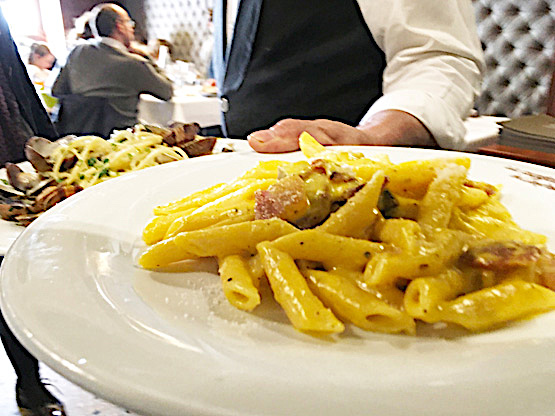 bacon
(below)—they actually use penne,
not spaghetti—but they have certainly perfected
it (14€), along with other Roman pastas like cacio e
pepe (14€), cannelloni (14€), gnocchi with
oxtail (14€) and ravioli stuffed with cod and
pumpkin sauce (14€). The
grilled lamb chops called scottaditi—finger
burners—you pick up with your fingers and chew
off the bone (18€). And they have fried lamb’s
brains with artichokes (16€). There’s also a
fine array of antipasti displayed, and the
service staff couldn’t be nicer to a traveler.
bacon
(below)—they actually use penne,
not spaghetti—but they have certainly perfected
it (14€), along with other Roman pastas like cacio e
pepe (14€), cannelloni (14€), gnocchi with
oxtail (14€) and ravioli stuffed with cod and
pumpkin sauce (14€). The
grilled lamb chops called scottaditi—finger
burners—you pick up with your fingers and chew
off the bone (18€). And they have fried lamb’s
brains with artichokes (16€). There’s also a
fine array of antipasti displayed, and the
service staff couldn’t be nicer to a traveler.
 The Fazzi family opened L’Hostaria
Romana (via del Boccaccio 1 ) near the
Trevi Fountain 60 years ago, then turned it over
to the Camponeschi family in 1979. There
are two floors, one overlooking the street, the
other below ground in a room scrawled with
thousands of graffiti names and praises (left).
Always make a reservation because the place is
always jammed by those who love bucatini
all'amatriciana, spaghetti alla carbonara,
tonnarelli cacio e pepe, paccheri alla gricia
and ravioli
ricotta e spinaci. There is also baby
lamb, which feeds on the mint of the Roman
hillsides, tripe in a tomato and cheese
reduction, oxtail alla
vaccinara stew, and, as is common in
Rome, “Quinta Quarto” specials specific to the
day, like pasta e
fagioli on Tuesday and pasta e
ceci on Friday. (Current
prices are not listed on line but pastas are
around 10€.)
The Fazzi family opened L’Hostaria
Romana (via del Boccaccio 1 ) near the
Trevi Fountain 60 years ago, then turned it over
to the Camponeschi family in 1979. There
are two floors, one overlooking the street, the
other below ground in a room scrawled with
thousands of graffiti names and praises (left).
Always make a reservation because the place is
always jammed by those who love bucatini
all'amatriciana, spaghetti alla carbonara,
tonnarelli cacio e pepe, paccheri alla gricia
and ravioli
ricotta e spinaci. There is also baby
lamb, which feeds on the mint of the Roman
hillsides, tripe in a tomato and cheese
reduction, oxtail alla
vaccinara stew, and, as is common in
Rome, “Quinta Quarto” specials specific to the
day, like pasta e
fagioli on Tuesday and pasta e
ceci on Friday. (Current
prices are not listed on line but pastas are
around 10€.)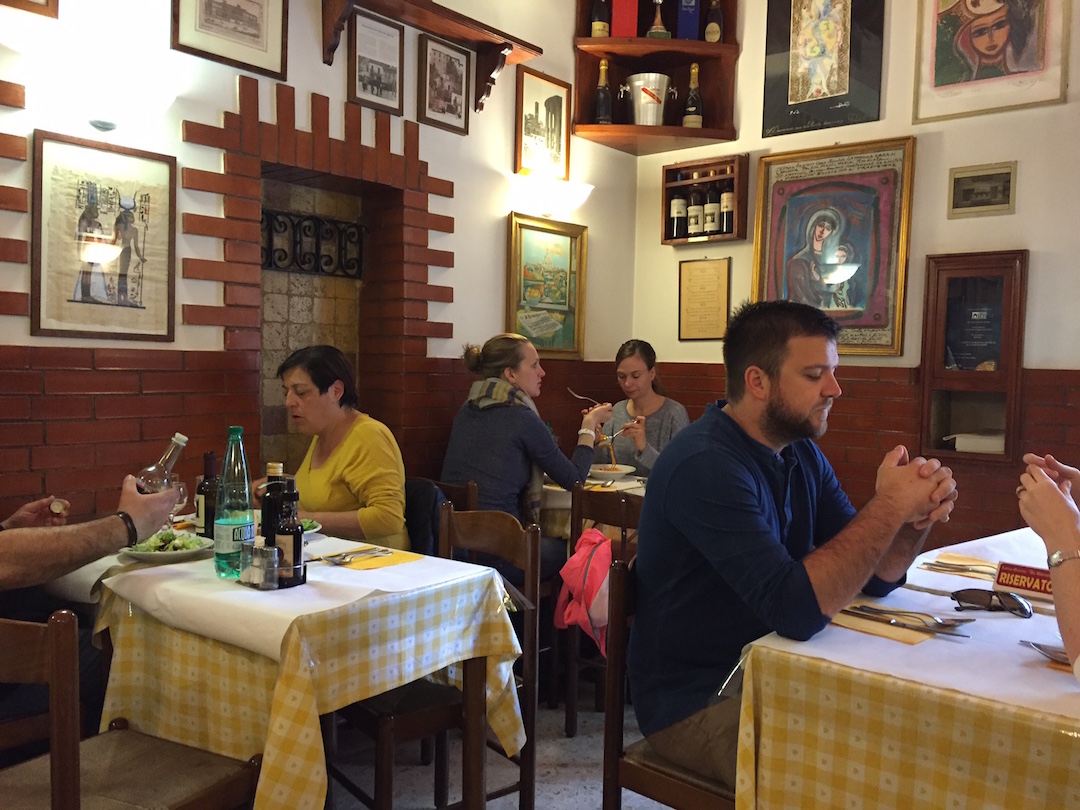
The
Trastevere neighborhood, across the Tiber,
almost comes as a quiet shock after the loud
bustle on the other side. Within winding streets
are scores of wonderful trattorias, including Antica
Osteria Da Giovanni (Via della Lungara, 41), not far
from the Vatican, with only about six tables (right),
plus one oddly placed in the
kitchen. It’s been there since 1951
and is a two-man show—the amiable owner, who
waits on every table, and the cook in the
back. The menu is very simple,
whatever’s good that day you want to eat. All four
pastas are, believe it or not, still 5€, all the
main courses 6€. The long-simmered meat ragù is
lavished over ravioli, and the roast rabbit is
excellent, tender and suffused with rosemary.
❖❖❖
SICILY OSTERIA
330 West 46th
Street
646-609-3416
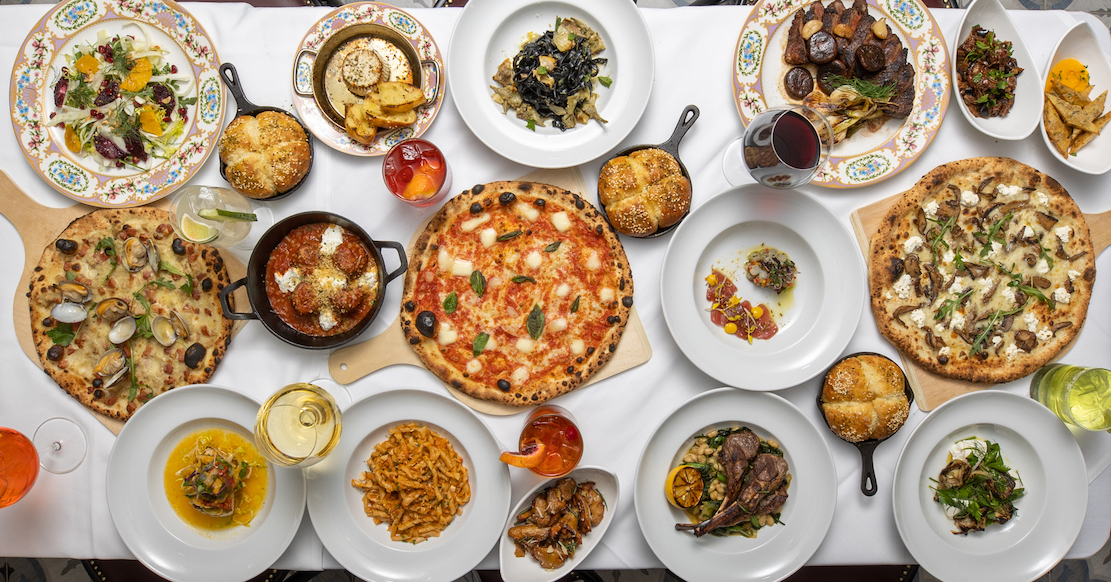
By John Mariani
The word
“unique” is very specific: one of a kind
(you can’t be “sort of unique” or “ very
unique”), and I use it deliberately to
describe the marvelous new Sicily Osteria in
the Theater District. Open just three weeks
(replacing Brazil, Brazil), it has a
delightful outdoor section of greenery (not one
of those decrepit sheds on the 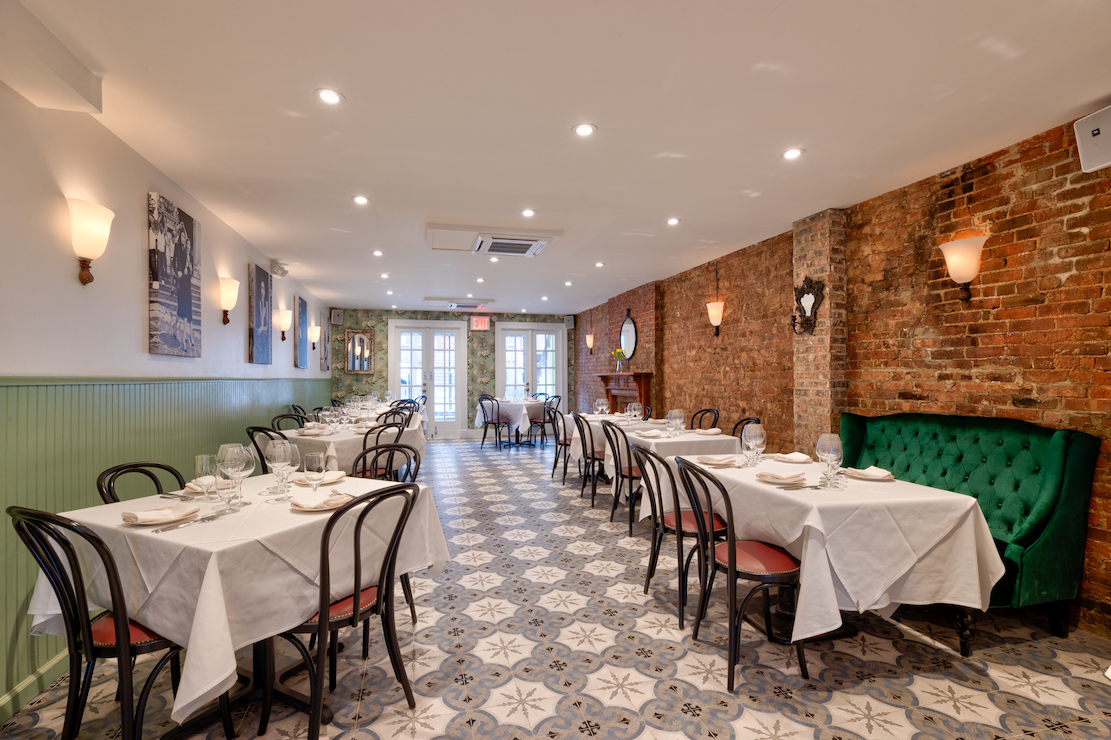 street) and inside,
two rooms as close to a true hostaria
as you’ll find, but more warmly lighted,
with brass table lamps, good linens and
wineglasses, vintage china, tile floors and
washed brick walls that make it look as
rustic as any restaurant in Taormina. Out
back there are tables under a skylight.
There is also a large photo of the owners’
beloved mama. Loud music
does not intrude.
street) and inside,
two rooms as close to a true hostaria
as you’ll find, but more warmly lighted,
with brass table lamps, good linens and
wineglasses, vintage china, tile floors and
washed brick walls that make it look as
rustic as any restaurant in Taormina. Out
back there are tables under a skylight.
There is also a large photo of the owners’
beloved mama. Loud music
does not intrude. 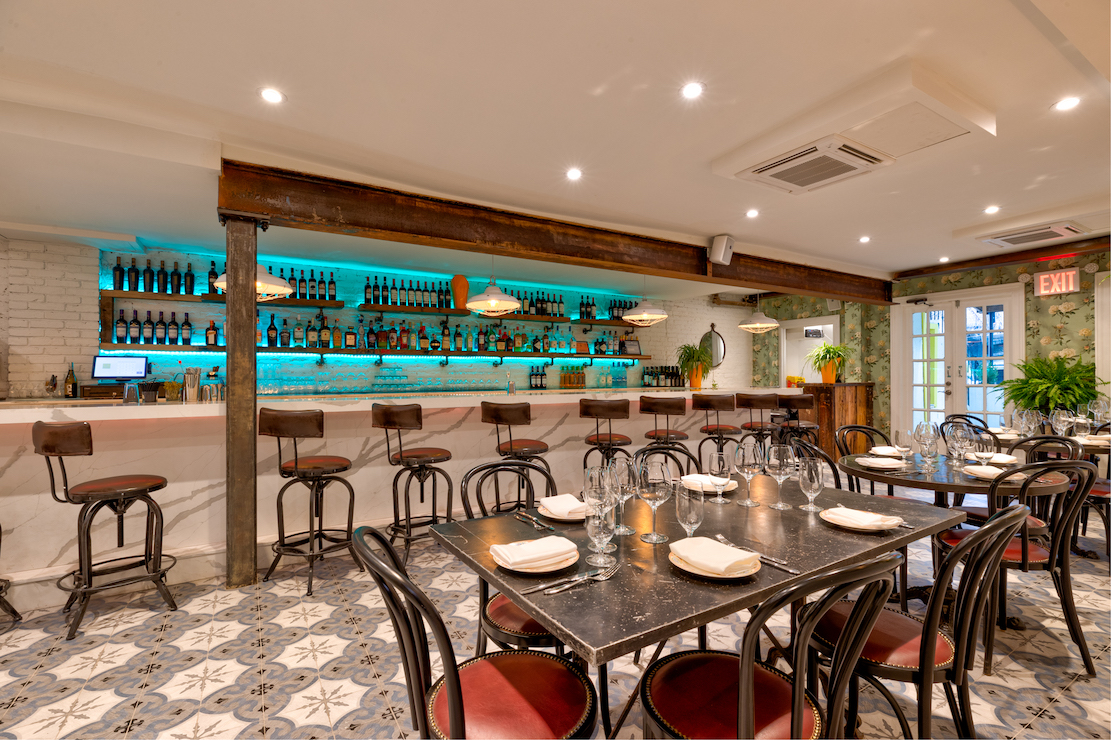
Décor alone does not make Sicily
Osteria unique, but its commitment by owners
Enrico and Robert Malta of New York City
Restaurant Group to serve rigorously authentic
Sicilian food does. In recent years the food
media have noted a return to favor of “red
sauce” Italian-American restaurants, along
with some places that purport to be Sicilian.
(The downtown Eataly flirted with southern
Italian food but has now switched to Tuscan). But
Sicily Osteria has an all-Sicilian
menu that takes into account the significant
varieties of cooking on the big island, from
Palermo to Catania, from Agrigento to
Siracusa.
The Maltas have, since arriving in the
States in 1962, run numerous Italian
restaurants, including Bocca di Bacco and
Puttanesca. Here they’ve gone full tilt with
their native cuisine, and while co-chef Asi
Maman was born in Israel, he’s worked half his
life in Italian kitchens, including some of 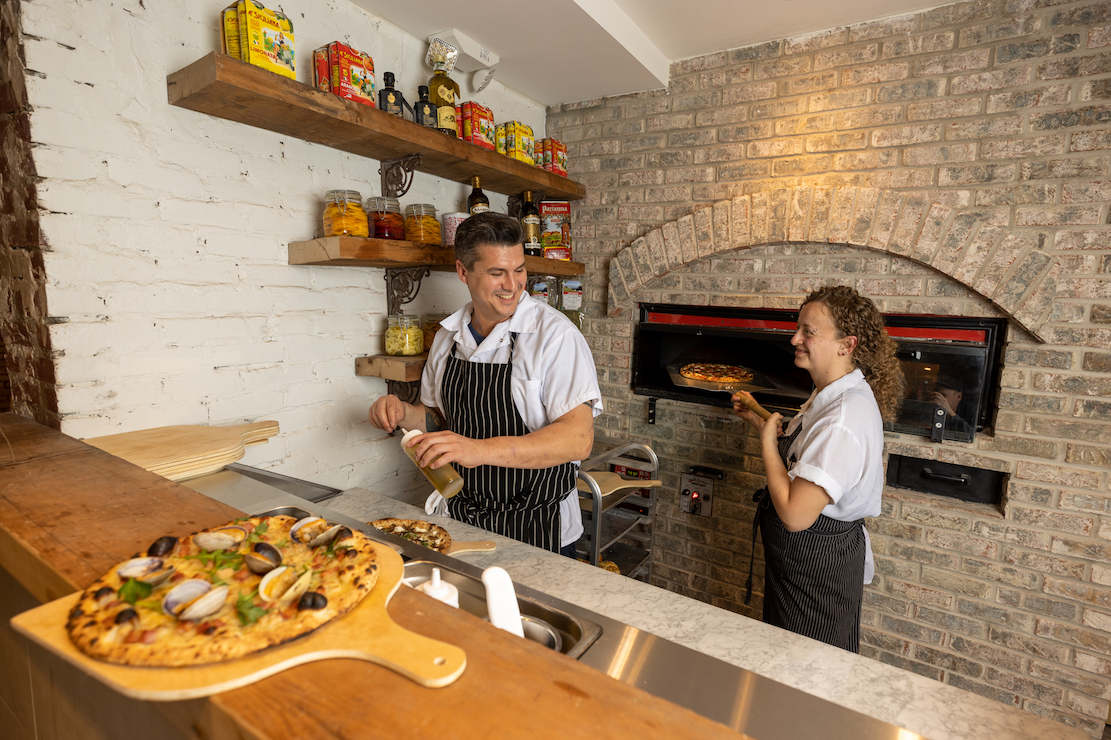 New
York’s finest like Marea and Osteria Morini, while
co-chef Heather Pelletier adds another
dimension acquired from her tenures at
Vaucluse, Osteria Morini and Chumley’s.
New
York’s finest like Marea and Osteria Morini, while
co-chef Heather Pelletier adds another
dimension acquired from her tenures at
Vaucluse, Osteria Morini and Chumley’s.
The restaurant’s motto is
the family’s: “Si Mangia
Bene, Si Paga Poco”—“eat well, but spend
a little”—based on the best products
available.
Sicily Osteria is not cheap, with
pastas $18-$26 (about the same as Orso next
door) but nowhere close to the prices at Marea
and Ai Fiori. A 14-ounce bistecca
is just $38. And there are dozens of wines
under $60 a bottle.
The first category on the menu is
called “La Strada,” meaning foods of the
street, which includes wonderful little puffs
of pannelle
($7), chickpea fritters (below) with
lemon and fresh herbs that you will gobble up.
There is also an antipasto duo of crudi ($16)
composed of raw red tuna dashed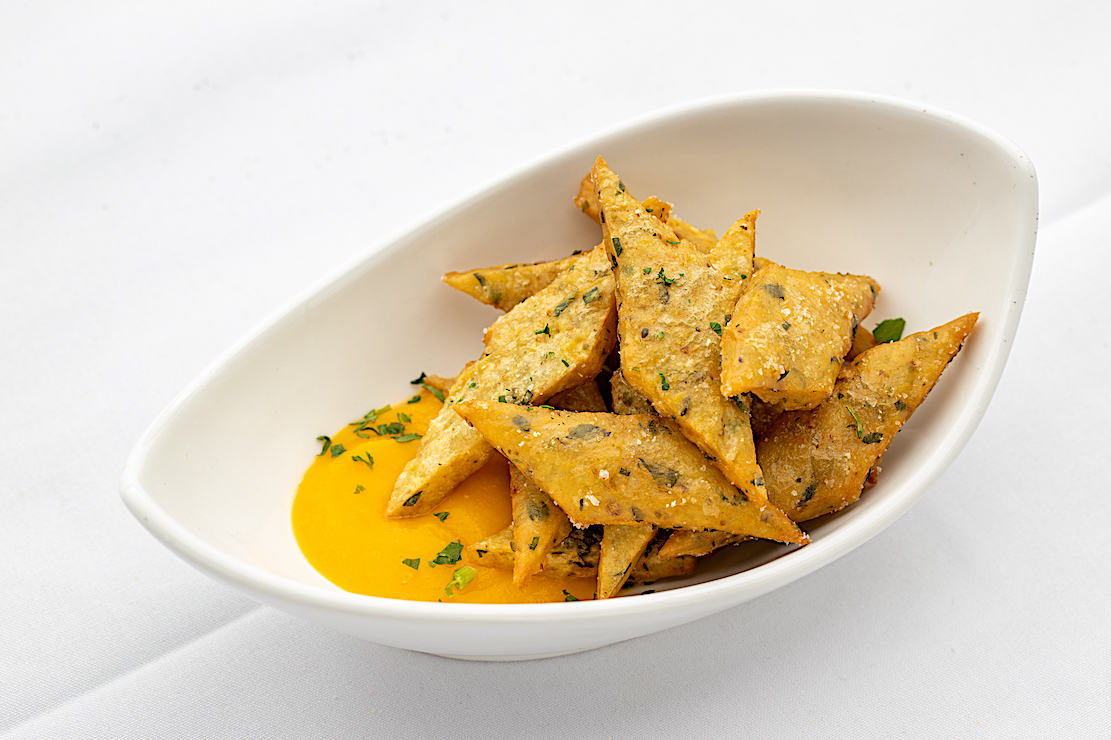 with
limoncello, nuts and seeds, and bass with a
sweet pepper relish scented with mint. Gently
grilled octopus ($16) comes with wild rice,
pignoli and a balance of sour lemon and sweet
cherries.
with
limoncello, nuts and seeds, and bass with a
sweet pepper relish scented with mint. Gently
grilled octopus ($16) comes with wild rice,
pignoli and a balance of sour lemon and sweet
cherries.
The pizzas are available in Sicilian or
the ubiquitous thin crust style, and the
former is a perfect example of the island’s
puffy, yeasty soft crusted variant, best with
eggplant and tomato.
Every pasta I tasted ranked among the
best of its kind in New York and very close to
what I’ve had in Sicily, including Palermo’s
classic, paccheri
alla Norma ($18), named after the
Bellini opera that debuted in that capital
city, 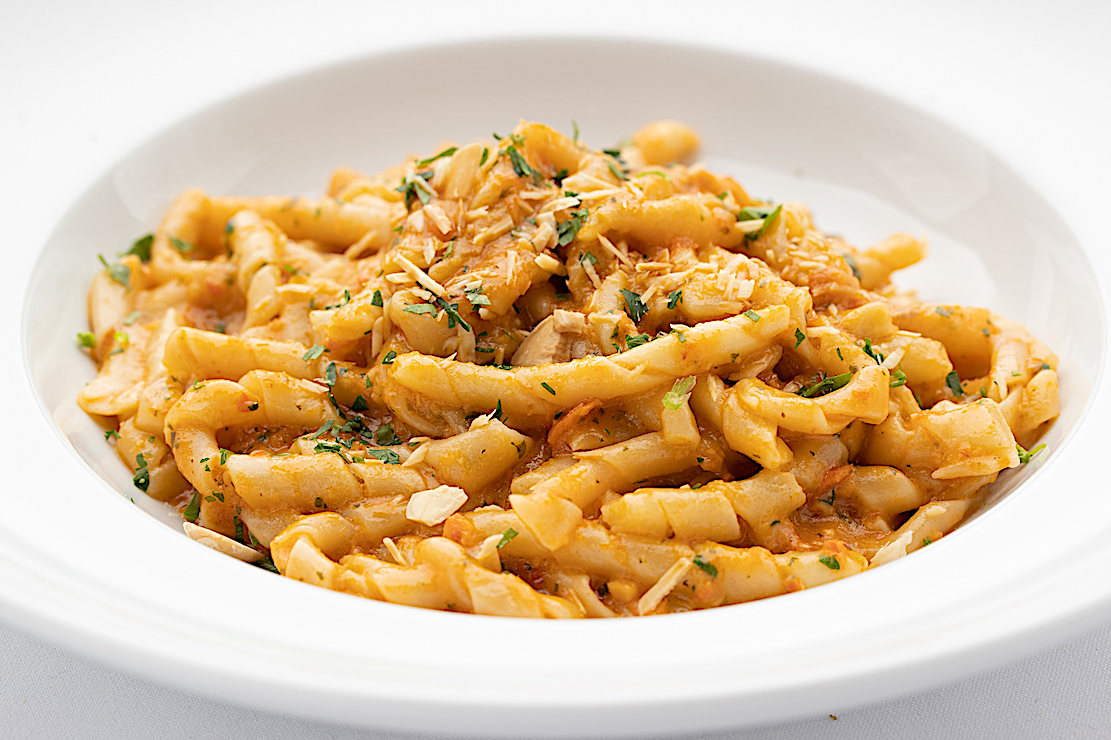 with tender
eggplant, vibrant tomato and ricotta
salata. Busiate
alla Trapanese ($18) has a sauce of
roasted tomato and an almond pesto, basil and
pecorino (below),
while squid-ink linguine
nere ($24) is abundant with clams and
artichoke and a sprinkling of mint.
Their lasagna Sicily-style ($22) is a
generous layering of pasta sheets with sweet
and hot sausage, broccoli
di rabe and a luscious tomato béchamel.
with tender
eggplant, vibrant tomato and ricotta
salata. Busiate
alla Trapanese ($18) has a sauce of
roasted tomato and an almond pesto, basil and
pecorino (below),
while squid-ink linguine
nere ($24) is abundant with clams and
artichoke and a sprinkling of mint.
Their lasagna Sicily-style ($22) is a
generous layering of pasta sheets with sweet
and hot sausage, broccoli
di rabe and a luscious tomato béchamel.
Main dishes (secondi)
in Sicily tend to be simple, although the parmigiana
di melanzane ($20) is rich indeed. Like
every other Italian restaurant in New York,
there is the requisite grilled branzino
($32), but a more western Sicilian choice
is the pesce
spada (swordfish) with a diced
eggplant-pepper caponata
($32) with tangy-sweet flavor. 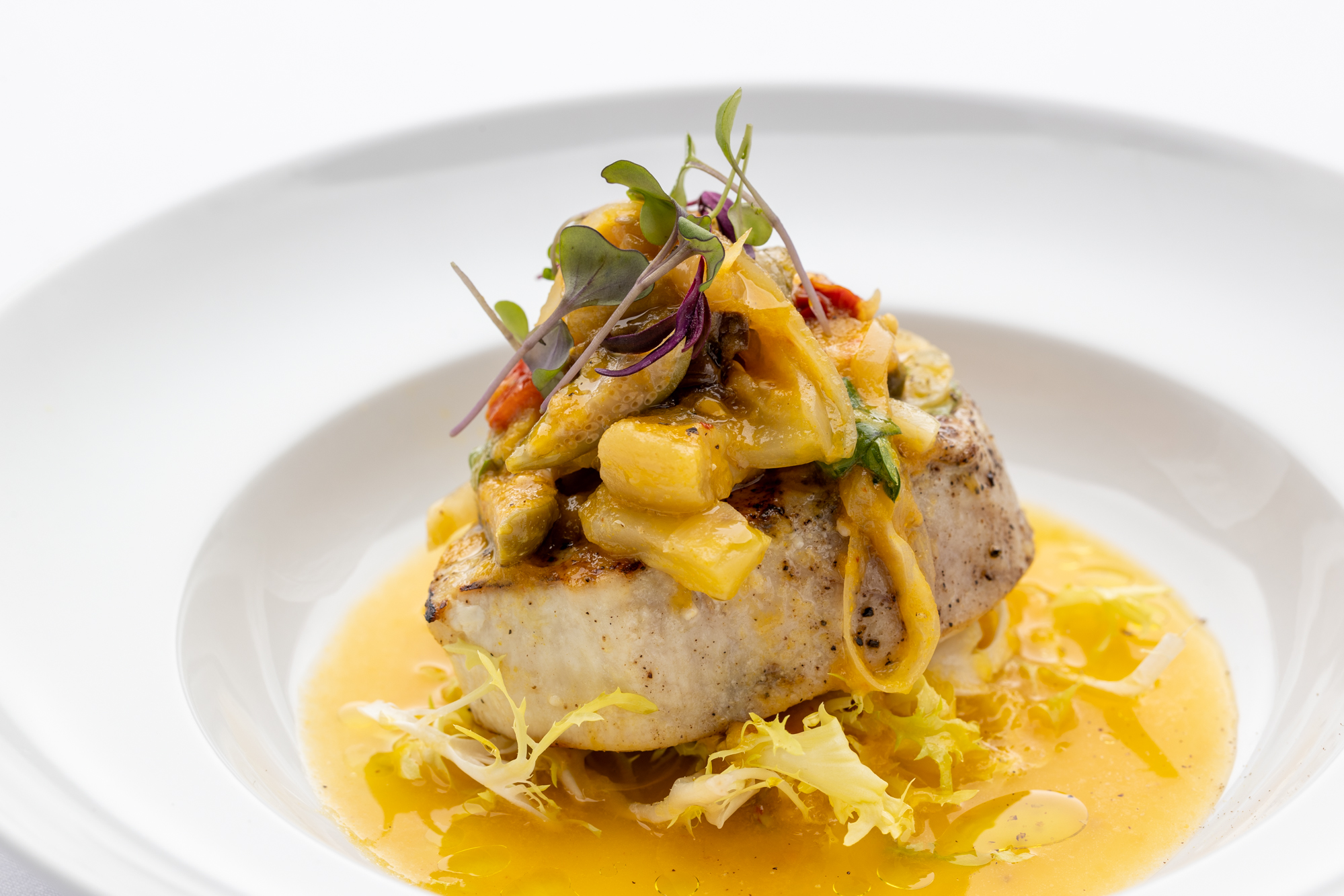
Sicilians have always made some of the
country’s best desserts, and here you see why:
Crunchy house-made cannoli ($10) contain sweet
ricotta, Amarena cherry and bits of chocolate,
while “Mount
Etna” is a pistachio lava cake with a fig
gelato ($13), and torta
settevelli is a seven-layer chocolate
hazelnut mousse cake ($13) well worth sharing.
Espresso, by the way, is well rendered (if you
ask it to be).
Theater District restaurants have a
history of customers rushed in and out before
7 o’clock, and I trust Sicily Osteria will
give them a good meal before they dash off to
a show. But that just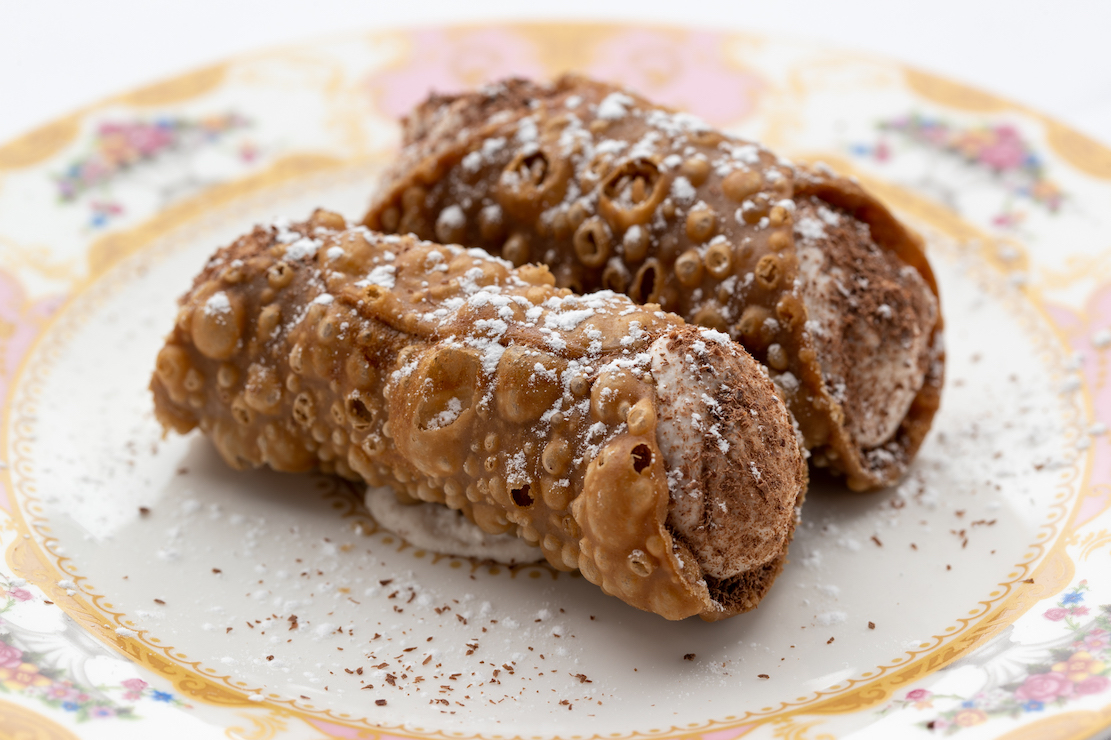 means the
rest of us can bask in the moment after they
all leave and we can enjoy it in a more
relaxed mode.
means the
rest of us can bask in the moment after they
all leave and we can enjoy it in a more
relaxed mode.
Sicily
Osteria is indeed a place to linger
over your food, sip your wine and be assured
that you are dining on food difficult to find
this well made anywhere else in New York. And,
if you snag a table outside, you might dine
beneath a New York moon and watch the
wonderful and colorful bustle of people
exiting the theaters after seeing Phantom
of the Opera or The Lion
King. It’s a very happy place to be.
❖❖❖
ANOTHER VERMEER

David, feeling
more inadequate than
unhelpful with Katie’s project, was encouraged
by her wanting him to stay on
the job. He was learning a good deal about the
art world and how it operates—a
far cry from how the New York mobs worked—and
saw enormous potential for crimes
to be committed within its ranks, from the
forgers to the swindlers, from the
auction houses only interested in making a sale
to the museums desperate to get
their hands on the rarest pieces out there.
While at the library, he had read that a
former curator of the
Metropolitan Museum of Art once said he believed
up to forty percent of the
artwork in some of the world’s finest museums
are either forgeries or
mis-attributed.
Then,
of course,
there were all those rich people in the shadows,
billionaires who spoke only to
each other and made deals without always defining
provenance, buying, selling
and exchanging stolen artworks from the Middle
East, South America and Asia.
Wherever there was a war going on, there was art
theft, and there were few
scruples among the super rich when it came to
owning something their
competitors could only dream of.
And, beyond all that, he had his time with
Katie, who he
thought was not totally out of reach for a man his
age—they got on very, very
well and had been through some dangerous
moments—but he also felt that every
day he got older she was still in the full bloom
of her life.
There were times when he dismissed it all
as mere
infatuation and times when he really thought he
was in love with her. Then
there were other times he reminded
himself he could be her father, had he gotten
married and had a daughter when
he was twenty. So, until he figured it out, or
Katie grew closer to him, he was
just damn happy to be with her as often as he
could and to be of some help in
her career.
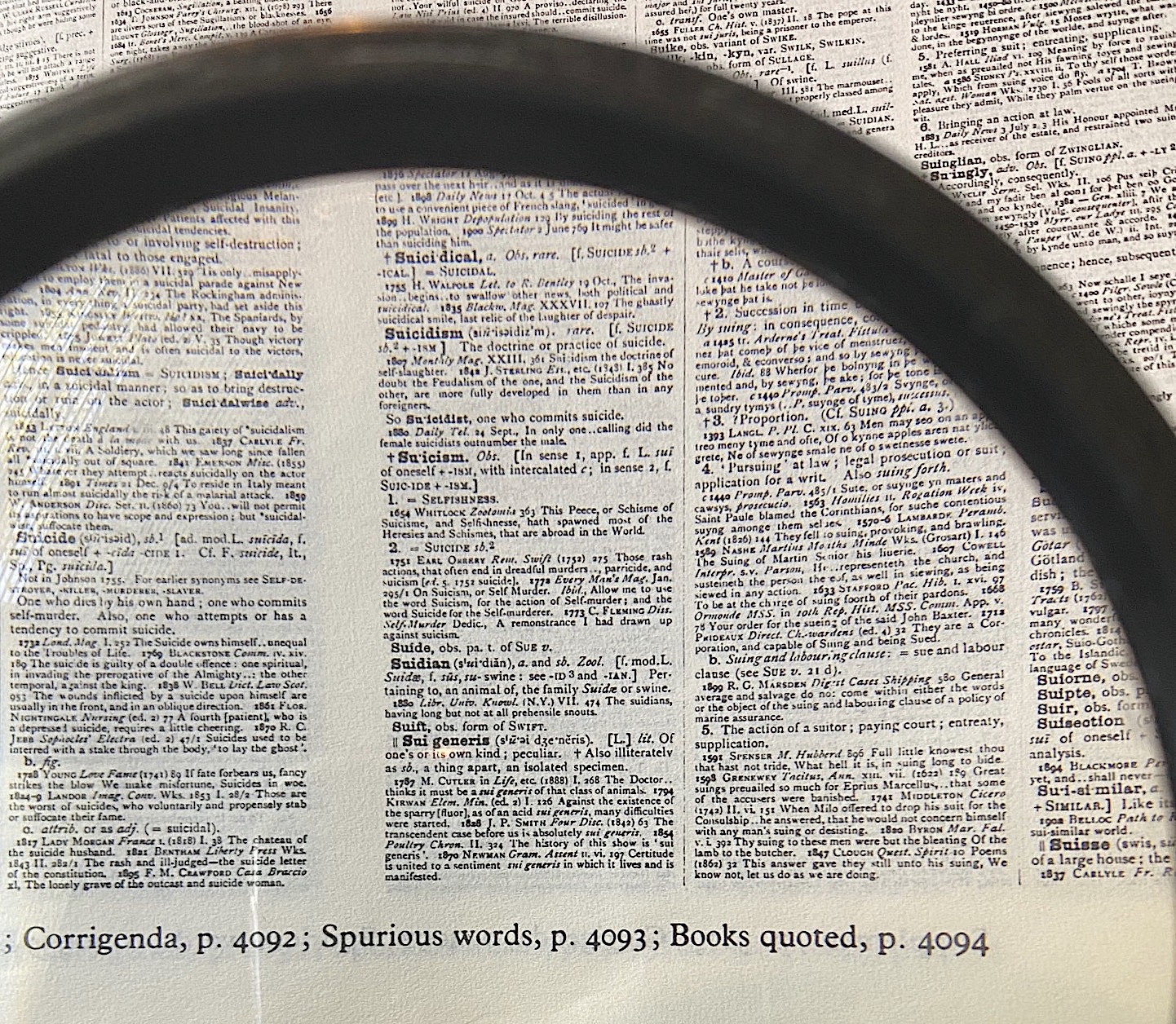 For her part
David was no father figure—she already had a
father she adored—and, after all they’d gone
through, although she felt closer
to David than to any of her friends, Katie was
very careful never to let him
think there could be a romance between them. Her
own love life had involved a
few affairs and “the lawyer guy” was still
somewhere in the picture. But
Katie’s independent streak was a wide one and it
was something many men could
not abide in a long-term relationship.
It made her feel good that she could always
count on David for anything
and for a long time to come.
For her part
David was no father figure—she already had a
father she adored—and, after all they’d gone
through, although she felt closer
to David than to any of her friends, Katie was
very careful never to let him
think there could be a romance between them. Her
own love life had involved a
few affairs and “the lawyer guy” was still
somewhere in the picture. But
Katie’s independent streak was a wide one and it
was something many men could
not abide in a long-term relationship.
It made her feel good that she could always
count on David for anything
and for a long time to come.
The phone rang in her apartment and it was
Prof. Mundt on
the line. “Oh, Katie, I am calling you about the
Vermeer painting. Do you
recall I said the words on it might be ‘sui
generis,’ and Prof. Lìu suggested it was
Chinese instead? Well, I was
somewhat skeptical at first, but I think she may
be closer to the truth than I
was.”
“How so?” asked Katie.
“Well, I was speaking to one of the Latin
professors
here—perhaps you remember him, Father Ignatius
Ryan?—and I mentioned ‘sui generis’
to him, and he told me that
it is really not an
old Latin term.
He said it was new Latin, using original Latin
words to create a new idea. So
we looked up the phrase in the Oxford
English Dictionary and found that its first
printed appearance, at least in
an English book, was in 1787, which is more than a
century after Vermeer painted The
Alchemist.
I doubt very much the
Dutch were using the term back in 1668.
And it makes that ‘G’ more
likely to be a ‘J.’”
“That is so amazing,” said Katie. “Prof.
Mundt, thanks so
much for letting me know. It
really
makes the Chinese connection so much stronger.”
“Ah, Katie, a scholar is of no use to the
student if he is
not ready to be educated himself.”
The two chatted socially for a few minutes,
but Katie’s mind
was racing. After 350 years could there actually
be a connection to the
present-day Mr. Hai Shui, or to any other member
of an extended family that had
been around for a millennium? The
chances seemed slim, but Hai Shui’s living in
Taiwan and being a billionaire
art collector certainly seemed more than a
coincidence.
Then again, all the billionaires on Gerald
Kiley’s short
list had good reason to be in the bidding for the
painting, but until the work
was actually on the auction block—after a period
of examination—none would make
a play.
“Curiouser
and curiouser,” Katie said to
herself each time a new piece of the puzzle
emerged.
*
*
*
*
Art
Today always
came out on a Wednesday, and the phone calls about
the Vermeer always came the
Monday before, so Coleman and Katie both had
reason to hope that the next call
would be coming this Monday.
Coleman had just returned from lunch when
he heard his
office phone ringing. He
grabbed it and
said, “Art
Today, Coleman here.”
“Ah, Mr. Coleman,” said a familiar voice,
“I have some news
you can certainly use.”
“O.K., shoot.”
“The Vermeer is about to make its first
public appearance.”
Coleman grabbed a pen and started writing
on a pad. “That’s
great news. Where and when?”
“At a gallery in Hong Kong, where it will
be open to
discreet inspection by approved experts on 17th
century Dutch art.”
“Has the owner been announced?”
When Coleman heard who it was, he was
astonished.
Almost as soon as the woman hung up, Katie
rang Coleman.
“Well, it’s Monday,” she said. “Any news?”
“Yeah, I’d say so,” said Coleman. “You
sitting down?”
“That big a deal, huh? So what is it?”
“Well, the painting is about to become
public, as is the
owner, and, once it’s been looked at by experts,
it’s going to be auctioned off
in—you ready for this?—Hong Kong.”
“Hong Kong? Why would the owner show it in
Hong Kong?”
“I know. If it were Chinese or Asian art—a
Ming vase or
ancient jade figures—it would have been a natural
thing for it to debut in Hong
Kong. Both Christie’s and Sotheby’s have auction
houses there. But for a
Vermeer? That’s highly unusual.”
“O.K., I’m sitting down, John,” said Katie,
her pen
poised.
“Who’s the owner? Someone
prominent in the art world in Asia?”
“Prominent in Asia, yes, you could
certainly say that,” said
Coleman.
“And can you tell me who that is?”
“Yes, I can. The current owner of the
Vermeer is the
People’s Republic of China.”
© John Mariani, 2016
❖❖❖
 OR JUST STAY IN BED AND
ORDER IN
OR JUST STAY IN BED AND
ORDER IN
“Do not go to Claw & Hammer on a date. Or to
be more exact, do not go to Claw & Hammer on a
first date. Go on a seventh or eighth date, when
the deed has been done, and you’ve seen each
other being about as messy and human as it’s
possible to be. Then this restaurant on the
eastern edge of the city of London, which
specializes in southern US seafood boils, will be
just the thing.”—Jay Rayner, “Claw and Hammer,” The
Observer (3/4/22).
❖❖❖
Any of John Mariani's books below may be ordered from amazon.com.
 The Hound in Heaven
(21st Century Lion Books) is a novella, and
for anyone who loves dogs, Christmas, romance,
inspiration, even the supernatural, I hope you'll find
this to be a treasured favorite. The story
concerns how, after a New England teacher, his wife and
their two daughters adopt a stray puppy found in their
barn in northern Maine, their lives seem full of promise.
But when tragedy strikes, their wonderful dog Lazarus and
the spirit of Christmas are the only things that may bring
his master back from the edge of despair.
The Hound in Heaven
(21st Century Lion Books) is a novella, and
for anyone who loves dogs, Christmas, romance,
inspiration, even the supernatural, I hope you'll find
this to be a treasured favorite. The story
concerns how, after a New England teacher, his wife and
their two daughters adopt a stray puppy found in their
barn in northern Maine, their lives seem full of promise.
But when tragedy strikes, their wonderful dog Lazarus and
the spirit of Christmas are the only things that may bring
his master back from the edge of despair. WATCH THE VIDEO!
“What a huge surprise turn this story took! I was completely stunned! I truly enjoyed this book and its message.” – Actress Ali MacGraw
“He had me at Page One. The amount of heart, human insight, soul searching, and deft literary strength that John Mariani pours into this airtight novella is vertigo-inducing. Perhaps ‘wow’ would be the best comment.” – James Dalessandro, author of Bohemian Heart and 1906.
“John Mariani’s Hound in Heaven starts with a well-painted portrayal of an American family, along with the requisite dog. A surprise event flips the action of the novel and captures us for a voyage leading to a hopeful and heart-warming message. A page turning, one sitting read, it’s the perfect antidote for the winter and promotion of holiday celebration.” – Ann Pearlman, author of The Christmas Cookie Club and A Gift for my Sister.
“John Mariani’s concise, achingly beautiful novella pulls a literary rabbit out of a hat – a mash-up of the cosmic and the intimate, the tragic and the heart-warming – a Christmas tale for all ages, and all faiths. Read it to your children, read it to yourself… but read it. Early and often. Highly recommended.” – Jay Bonansinga, New York Times bestselling author of Pinkerton’s War, The Sinking of The Eastland, and The Walking Dead: The Road To Woodbury.
“Amazing things happen when you open your heart to an animal. The Hound in Heaven delivers a powerful story of healing that is forged in the spiritual relationship between a man and his best friend. The book brings a message of hope that can enrich our images of family, love, and loss.” – Dr. Barbara Royal, author of The Royal Treatment.
 |
The Encyclopedia of American Food and Drink by John F. Mariani (Bloomsbury USA, $35) Modesty forbids me to praise my own new book, but let me proudly say that it is an extensive revision of the 4th edition that appeared more than a decade ago, before locavores, molecular cuisine, modernist cuisine, the Food Network and so much more, now included. Word origins have been completely updated, as have per capita consumption and production stats. Most important, for the first time since publication in the 1980s, the book includes more than 100 biographies of Americans who have changed the way we cook, eat and drink -- from Fannie Farmer and Julia Child to Robert Mondavi and Thomas Keller. "This book is amazing! It has entries for everything from `abalone' to `zwieback,' plus more than 500 recipes for classic American dishes and drinks."--Devra First, The Boston Globe. "Much needed in any kitchen library."--Bon Appetit. |
"Eating Italian will never be the same after reading John Mariani's entertaining and savory gastronomical history of the cuisine of Italy and how it won over appetites worldwide. . . . This book is such a tasteful narrative that it will literally make you hungry for Italian food and arouse your appetite for gastronomical history."--Don Oldenburg, USA Today. "Italian
restaurants--some good, some glitzy--far
outnumber their French rivals. Many of
these establishments are zestfully described
in How Italian Food Conquered the World, an
entertaining and fact-filled chronicle by
food-and-wine correspondent John F.
Mariani."--Aram Bakshian Jr., Wall Street
Journal.
"Equal parts
history, sociology, gastronomy, and just
plain fun, How Italian Food Conquered the
World tells the captivating and delicious
story of the (let's face it) everybody's
favorite cuisine with clarity, verve and
more than one surprise."--Colman Andrews,
editorial director of The Daily
Meal.com. "A fantastic and fascinating
read, covering everything from the influence
of Venice's spice trade to the impact of
Italian immigrants in America and the
evolution of alta cucina. This book will
serve as a terrific resource to anyone
interested in the real story of Italian
food."--Mary Ann Esposito, host of PBS-TV's
Ciao
Italia. "John Mariani has written the
definitive history of how Italians won their
way into our hearts, minds, and
stomachs. It's a story of pleasure over
pomp and taste over technique."--Danny Meyer,
owner of NYC restaurants Union Square
Cafe, The Modern, and Maialino.
|
 |
 |
 |
 |
 |
 |
 Everett Potter's Travel Report:
Everett Potter's Travel Report: 
 Eating Las
Vegas JOHN CURTAS has been covering
the Las Vegas food and restaurant scene
since 1995. He is the co-author of EATING LAS
VEGAS – The 50 Essential Restaurants (as
well as the author of the Eating Las
Vegas web site: www.eatinglasvegas.
He can also be seen every Friday morning as
the “resident foodie” for Wake Up With the
Wagners on KSNV TV (NBC) Channel 3 in
Las Vegas.
Eating Las
Vegas JOHN CURTAS has been covering
the Las Vegas food and restaurant scene
since 1995. He is the co-author of EATING LAS
VEGAS – The 50 Essential Restaurants (as
well as the author of the Eating Las
Vegas web site: www.eatinglasvegas.
He can also be seen every Friday morning as
the “resident foodie” for Wake Up With the
Wagners on KSNV TV (NBC) Channel 3 in
Las Vegas.
MARIANI'S VIRTUAL GOURMET
NEWSLETTER is published weekly. Publisher: John Mariani. Editor: Walter Bagley. Contributing Writers: Christopher
Mariani, Misha Mariani, John A. Curtas, Gerry Dawes, Geoff Kalish.
Contributing
Photographer: Galina Dargery. Technical
Advisor: Gerry
McLoughlin.
If you wish to subscribe to this
newsletter, please click here: http://www.johnmariani.com/subscribe/index.html
© copyright John Mariani 2022

